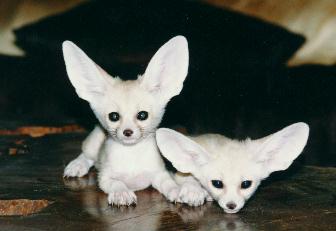Fennec
Fox
Fennec Foxes can be leash-trained and litter trained.
The Fennec Fox, (Vulpes zerda),
(formerly aka Fennecus zerda), is from the arid regions of Northern Africa
and is the smallest wild canid today. At birth, these little fox are barely
an ounce in weight and are covered with a light peach fuzz. Their skin is
charcoal gray where the dark markings will be in their hair when they are
adults. At birth, their ears are folded over just like domestic dog puppies
and are sealed shut just like their eyes. They nurse their mother for about
10 weeks in an underground den.
At about 12-14 days their eyes open for the first time - their bright, jet
black shiny eyes. If you are hand-raising the pups, they will look you straight
in the eye from the moment they open their eyes. It is an incredible sensation
when your own eyes make contact with theirs. The tiny ears stand up at about
2 weeks. But that is when the magic begins. From that time on, it seems
that the ears are the fastest growing part of their body. You can actually
measure the change daily. Within a short time they have full-sized ears
and still have a small kit's body. The ears are a marvelous adaptation of
nature. As pups, you can see the blood vessels throughout their ears and
it is thought that their blood circulating through the ears is cooled -
thereby helping to dissipate body heat during the hot part of the day.
Fennec males are good dads and will help the mother protect her young but
mom will not let the father interact with the pups until they start to play
at the den entrance at about 5-6 weeks. Fennec foxes, like many animals,
somehow miraculously adjust the size and numbers of their litters to the
available food supply. Normally they produce only one litter a year of from
2-5 young. If the young are killed, they will produce another litter if
the food supply is plentiful.
They are sexually mature at about 9 months of age. As adults, they will
weigh about 2 to 3.5 lb. They have a lovely, soft, thick coat of silky-textured
fur. Their under parts are off-white and the upper parts are light with
a tawny to reddish glow. The tail is tipped with black. Their whiskers,
nose and eyes are black. Their faces are absolutely stunning to look at
with the ultimate innocent look. They have fur on the soles of their feet
to protect the pads from hot sand and to help them travel in soft sand.
Fennecs are rapid diggers and are well noted for this feat. Natives tell
a tale that they can disappear in the sand while standing still. I do not
know about that, but they can dig 20 feet in one night - I have seen that
feat myself!
Coffee, Tea, Or ME? 3 week old baby Fennec Fox
In Captivity
Fennecs can make amazing animals
for zoo displays and animal educators. They are very fox-like in their movements
being quick and agile. They are easily trainable and fastidiously clean
about their bodies. They can be trained to a litter box, similarly to a
cat. We recommend a litter box that has a protective shield, however, as
they can scatter the litter great distances. Clumping litter may not be
a good choice for this species. We have had both good and bad luck with
it. We find that it will sometimes adhere to the fur on their foot pads,
forming hard pieces that must be removed. Fennecs also have a habit of dragging
their food from a dish to their favorite spot in their enclosure. That could
be the litter pan and if so, they will ingest some of the litter with their
food.
Fennecs are diggers in the wild and that does not change in captivity. They
need a release for this drive. We suggest daily exercise from the age of
weaning such as directing their energies to chasing and retrieving toys.
We have taught them to retrieve small soft dumbbells and toys. They bring
them back and lay them on our feet - After they 'kill' the toy. They are
truly a joy.
Fennecs can make endearing companions if the owner is willing to train them
to a leash. These, as well as most exotics, should never be taken outside
without a leash (if not in a container). Wild instincts are possible to
modify but never can be over-ridden. The instinct to search and hunt will
over-ride their training and attachment for you and they will scamper off
in pursuit of a grasshopper or other fast moving creature without giving
you a second thought at the time. They could easily be lost in a flash.
Food can be raw meat, vegetables and vitamins. We feed DRY Mazuri Wild Canid
Food (Made by Purina and can be ordered in 25 lb. bags through your Purina
FEED store). This food is complete and no vegetables or vitamins need to
be added. We understand many people have been successful with Iam's kitten
food. We prefer not to feed raw meat to any of our house, companion or educational
animals. We feel the animals have a quieter nature on commercial food. We
also find that the Fennec has little odor but if it is fed a diet of raw
meat the urine may develop a strong odor. We furnish a complete diet and
care instructions with all of our animals.
The Fennec Fox is on Appendix II of CITES. It is not on the USDI list of
Endangered/Threatened animals.
More Pictures:
Fennec Fox - 3 Days old"
Fennec Fox With A Prairie Dog (Enemies in the wild)
R-Zu-2-U Home
R-Zu-2-U FAQs
R-Zu-2-U Animal "Terms"
Treasure Ranch Home


